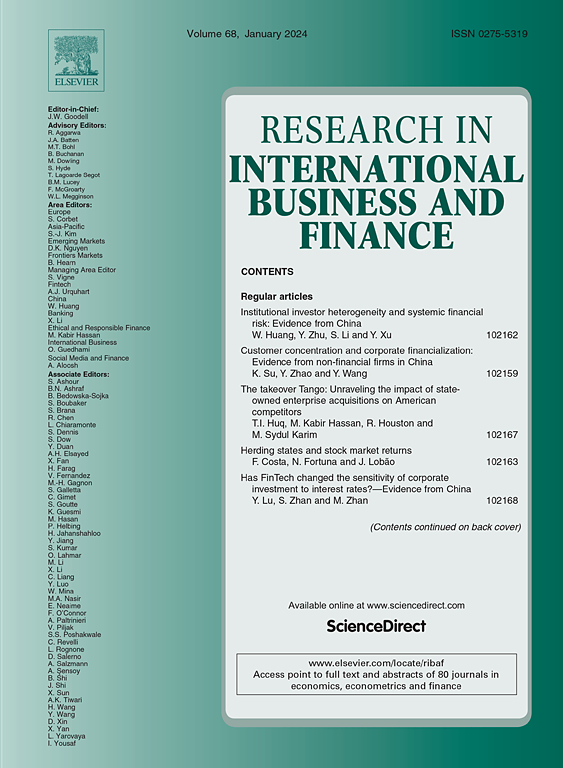中游企业的供应链ESG和绿色创新:供应商和买方的整合方法
IF 6.3
2区 经济学
Q1 BUSINESS, FINANCE
Research in International Business and Finance
Pub Date : 2025-05-19
DOI:10.1016/j.ribaf.2025.102986
引用次数: 0
摘要
我们采用综合考虑供应商和买家ESG得分的方法,对供应链ESG对企业绿色创新的影响进行了实证分析。利用2009-2022年中国企业层面的数据,我们的研究结果表明,较高的供应链ESG得分显著促进了中游企业的绿色创新。对ESG绩效进行分解后发现,供应商和客户的ESG绩效都有显著影响。机制分析表明,改善ESG有助于缓解融资约束,提高供应链效率,稳定供需关系。异质性分析表明,供应链集中度越高,距离越短,正向影响越大。环境和社会支柱对绿色创新的影响强于治理支柱,良好的ESG绩效促进了联合绿色创新。这些发现强调了考虑供应链双方和采用整体ESG管理方法以最大限度地发挥绿色创新潜力的重要性。本文章由计算机程序翻译,如有差异,请以英文原文为准。
Supply chain ESG and green innovation at midstream firms: An integrated approach with both supplier and buyer sides
We conducted an empirical analysis of the impact of supply chain ESG on corporate green innovation, adopting an integrated approach that considers the ESG scores of both suppliers and buyers. Using firm-level data from China for the period 2009–2022, our results indicate that higher supply chain ESG scores significantly promote green innovation in midstream companies. Disaggregating the ESG performance shows that both suppliers’ and customers’ ESG performance have a significant impact. Mechanism analysis shows that better ESG helps to alleviate financing constraints, improve supply chain efficiency, and stabilize supply-demand relationships. Heterogeneity analysis indicates that high supply chain concentration and shorter distances enhance the positive impact. Furthermore, the environmental and social pillars have a stronger influence on green innovation than the governance pillar, and better ESG performance increases joint green innovation. These findings highlight the importance of considering both sides of the supply chain and adopting a holistic ESG management approach to maximize the potential for green innovation.
求助全文
通过发布文献求助,成功后即可免费获取论文全文。
去求助
来源期刊

Research in International Business and Finance
BUSINESS, FINANCE-
CiteScore
11.20
自引率
9.20%
发文量
240
期刊介绍:
Research in International Business and Finance (RIBAF) seeks to consolidate its position as a premier scholarly vehicle of academic finance. The Journal publishes high quality, insightful, well-written papers that explore current and new issues in international finance. Papers that foster dialogue, innovation, and intellectual risk-taking in financial studies; as well as shed light on the interaction between finance and broader societal concerns are particularly appreciated. The Journal welcomes submissions that seek to expand the boundaries of academic finance and otherwise challenge the discipline. Papers studying finance using a variety of methodologies; as well as interdisciplinary studies will be considered for publication. Papers that examine topical issues using extensive international data sets are welcome. Single-country studies can also be considered for publication provided that they develop novel methodological and theoretical approaches or fall within the Journal''s priority themes. It is especially important that single-country studies communicate to the reader why the particular chosen country is especially relevant to the issue being investigated. [...] The scope of topics that are most interesting to RIBAF readers include the following: -Financial markets and institutions -Financial practices and sustainability -The impact of national culture on finance -The impact of formal and informal institutions on finance -Privatizations, public financing, and nonprofit issues in finance -Interdisciplinary financial studies -Finance and international development -International financial crises and regulation -Financialization studies -International financial integration and architecture -Behavioral aspects in finance -Consumer finance -Methodologies and conceptualization issues related to finance
 求助内容:
求助内容: 应助结果提醒方式:
应助结果提醒方式:


